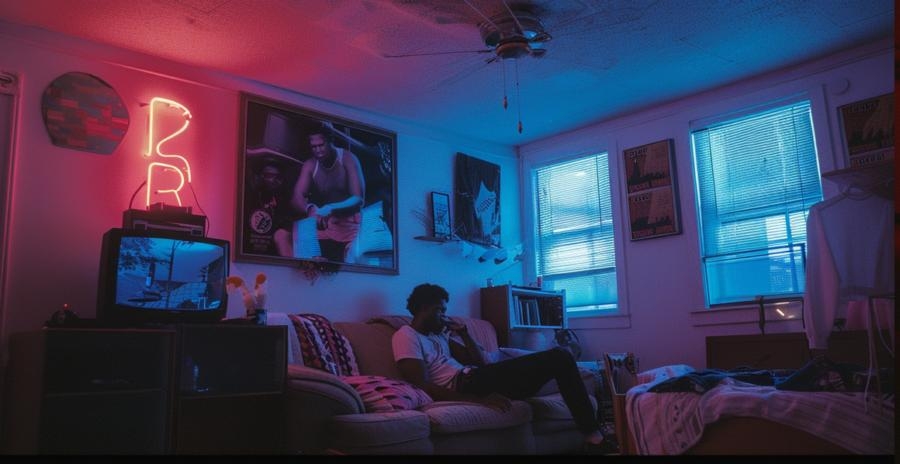Making Neon Work in a Lived-In Home
 Neon signs are cool. They're also potentially very uncool when they’re mounted poorly, flickering like a haunted house prop, or humming near your toddler’s crib like they’re summoning an ancient god. If you live with children, animals, or humans you don’t biologically claim (hi, landlords), you’ll want to get this right. Because while neon might look harmless, some signs pack more volts than your toaster.
Neon signs are cool. They're also potentially very uncool when they’re mounted poorly, flickering like a haunted house prop, or humming near your toddler’s crib like they’re summoning an ancient god. If you live with children, animals, or humans you don’t biologically claim (hi, landlords), you’ll want to get this right. Because while neon might look harmless, some signs pack more volts than your toaster.
Voltage Isn’t Just a Number
Glass neon signs use high-voltage transformers that can run between 3,000 and 15,000 volts. That’s not a typo. It’s also not a conversation you want to have in an emergency room. Most quality signs are insulated and housed correctly, but DIY or second-hand signs might not be. If a curious toddler or a high-jumping cat gets access to the exposed electrode ends, you're not dealing with a mere “oops.”
If the sign buzzes audibly, heats up, or has visible metal parts anywhere near the wiring, assume it's a hazard. If it's vintage and has a transformer the size of a brick, you may also want to assume it was built during an era when lead paint was still casually invited to children’s birthday parties.
Mount Like You Mean It
Wobbly wall mounts are a problem in any home, but they’re an existential threat in homes with kids or pets who see everything as either a ladder or prey. Neon signs should be mounted with wall anchors—preferably into studs—and never just hung from a single screw or (God help you) a thumbtack.
Avoid placing them in high-traffic zones like above cribs, couches, pet beds, or the spot where your cat launches itself into full flight. Also, make sure the power cable is out of reach or neatly channeled along the wall. Cable clips and trunking are your friend. Loose cords are not just unsightly—they’re chew toys with a death wish.
Glass + Children = Emergency Google Searches
Traditional neon signs are made from hand-blown glass tubes filled with noble gases. Beautiful, yes. Durable, absolutely not. If the tube shatters, you’re dealing with a double-whammy: sharp glass and a potentially toxic release of gases like argon or neon—harmless in small doses, but not meant for direct lung appreciation.
Worse, some older signs use mercury vapor for that distinct blue glow. Mercury is not a substance you want misting around when your toddler is in footie pajamas licking things indiscriminately.
You can reduce risk by placing signs behind protective acrylic cases or opting for faux neon alternatives. The newer LED “neon” strips are flexible, plastic-coated, and disturbingly hard to break. You could probably throw one off a balcony and still hang it afterward—not that we recommend turning your balcony into a neon testing range.
Heat Happens, Even in Style
Traditional neon signs can get warm. Not fry-an-egg warm, but uncomfortable to the touch—especially around transformer points or poorly ventilated tubes. This might not matter if the sign is six feet up a wall in your home office. It *absolutely* matters if it’s a foot above your child’s changing table, where accidental contact is not a question of *if* but *how soon*.
Modern LED neon alternatives don’t heat up the same way, which is why they’re usually the smarter choice in shared homes. They’re also more energy efficient—pulling a fraction of the power of gas neon—and rarely require the sort of ventilation or spacing that glass-tube versions demand. Just don’t coil the cords or trap them behind flammable materials like curtains or foam insulation. You’re lighting up a space, not preparing for arson.
Renter-Friendly Solutions That Won’t Get You Evicted
Renters, take heart. You can still bask in soft neon glow without drilling holes or signing your security deposit away in blood. Look for signs that are:
- Battery-powered or USB-driven (low-voltage, no transformer)
- Mounted with 3M command strips, adhesive hooks, or wall-safe Velcro
- Lightweight—flexible LED signs are often under 2 lbs
- Equipped with auto shut-off timers or remote dimming options
These options keep the landlord happy, the walls intact, and the sign easy to relocate. Because nothing says “awkward move-out day” like chiseling a glass sign off a plasterboard wall while your new tenants arrive early.
Don’t Let Your Neon Hum Like It’s Possessed
That buzzing sound some neon signs make? It’s not ambiance. It’s usually a worn transformer, bad wiring, or poor insulation. While it might just be an annoying background noise during your dinner party, it can also signal electrical inefficiency—or worse, a prelude to failure.
In homes with babies or neurodivergent occupants sensitive to sound, that faint hum can be genuinely disruptive. If your sign buzzes more than a fridge from the 90s, replace the transformer or switch to a modern LED alternative. You want light, not noise pollution dressed up as mood lighting.
Also, watch out for flickering that isn't intentional (some signs have built-in flicker effects). Random dimming, ghost lighting, or irregular pulses can mean unstable voltage flow. That's not just an aesthetic flaw—it's a fire risk waiting for the right moment.
Surge Protection Isn’t Overkill
Neon signs aren’t always forgiving when it comes to power spikes. A power surge can fry your transformer or worse, send a dangerous jolt through exposed parts. If you live in an older building or one known for inconsistent power supply (hello, suspiciously cheap rentals), plug your neon into a surge-protected power strip. It’s the cost of a sandwich and could prevent your wall art from becoming a cautionary tale.
Also worth noting: never plug a neon sign into the same circuit as heavy-load appliances like fridges, microwaves, or portable heaters. You're trying to run a sign, not trip the breaker every time someone reheats soup.
Never Clean It Like a Regular Lamp
This one’s important. Never spray neon signs directly with cleaner. Don’t wipe them with a wet cloth. Don’t “dust” them with a vacuum brush attachment like you’re on autopilot. Always unplug the sign, let it cool, and use a dry microfiber cloth. If you have a glass neon, wear gloves—both to avoid cuts and to prevent your skin oils from weakening delicate parts over time.
And whatever you do, do not dismantle the sign to “see how it works.” This is how people end up in home repair threads wondering why their living room smells like burning plastic and sadness.
When in Doubt, Go Faux
If any part of this checklist made your eye twitch, it might be time to accept the beauty of faux neon. LED signs replicate the look of glass neon with none of the death-trap energy. They’re light, flexible, safe to touch, often battery-powered, and come with remote controls so you can adjust the glow without standing on your couch like an idiot.
They don’t buzz, don’t flicker (unless designed to), and don’t pose a mercury hazard when smashed by an enthusiastic dog tail. They also travel well—ideal for renters or commitment-phobes who want their aesthetic without architectural consequences.
Glow Without Regret
You can absolutely have neon in your home without becoming a cautionary tale for the local fire brigade. But it takes a little planning, a few smart choices, and a healthy respect for voltage. Whether you're lighting up a kitchen corner or turning your spare room into a cosmic lounge, the goal is to let the sign make a statement—not an insurance claim.
Choose safer tech. Mount it like a grown-up. Keep it out of paw range. And maybe—just maybe—don’t let your neon glow brighter than your sense of self-preservation.
|
|




 Neon signs are cool. They're also potentially very uncool when they’re mounted poorly, flickering like a haunted house prop, or humming near your toddler’s crib like they’re summoning an ancient god. If you live with children, animals, or humans you don’t biologically claim (hi, landlords), you’ll want to get this right. Because while neon might look harmless, some signs pack more volts than your toaster.
Neon signs are cool. They're also potentially very uncool when they’re mounted poorly, flickering like a haunted house prop, or humming near your toddler’s crib like they’re summoning an ancient god. If you live with children, animals, or humans you don’t biologically claim (hi, landlords), you’ll want to get this right. Because while neon might look harmless, some signs pack more volts than your toaster.